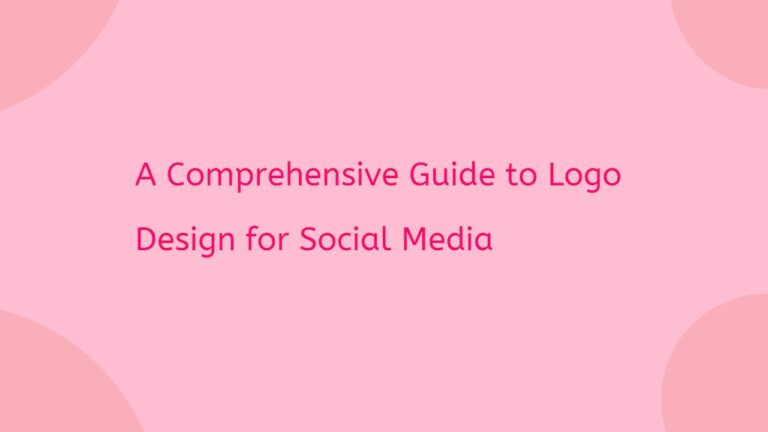
In today’s digital age, where attention spans are fleeting and visual content dominates social media platforms, a compelling logo is a non-negotiable element for any brand striving to make a mark. The art of designing logos for social media goes beyond aesthetic appeal—it involves understanding the intricacies of each platform, embracing simplicity, employing color psychology, ensuring scalability, and navigating legal considerations. In this in-depth guide, we will explore these crucial aspects to empower a logo creator and businesses to create logos that not only catch the eye but also resonate with their target audience in the dynamic digital landscape.
- Understanding the Social Media Landscape:
Social media platforms are diverse in terms of user base, content types, and technical specifications. Before embarking on logo design, logo designers must familiarize themselves with the unique requirements of each platform. From Instagram’s square profile pictures to Twitter’s circular ones, each platform has specific guidelines for logo dimensions, aspect ratios, and file formats. A well-designed logo should seamlessly adapt to these specifications, ensuring clarity and impact across the entire digital spectrum.
- Simplicity is Key:
In the age of information overload, simplicity reigns supreme. A logo should convey the essence of a brand in a split second, even when scaled down for use in a small profile picture or amidst a crowded feed. Λιβαισ Complex designs and intricate details are more likely to get lost in translation, diminishing the logo’s effectiveness. Therefore, logo designers must prioritize simplicity, aiming for a clean and memorable design that cuts through the noise of the digital landscape.
- Color Psychology and Brand Consistency:
Colors are powerful communicators, evoking emotions and conveying messages. Understanding color psychology is essential for a logo designer when choosing a palette that resonates with the brand’s values and connects with the target audience. Consistency is equally crucial—maintaining a uniform color scheme across various social media channels reinforces brand recognition. A harmonious color palette contributes to a cohesive online presence, making the brand easily identifiable and memorable.
- Scalability and Responsiveness:
A well-crafted logo should maintain its impact and clarity across a range of sizes and devices. The responsiveness of a logo is a critical factor—whether it’s viewed on a mobile screen, a desktop, or any other device, it should retain its visual appeal. Ensuring scalability involves testing the logo in different contexts, from a profile picture to a full-screen banner, to guarantee its effectiveness in various applications.
- Typography and Iconography:
Combining effective typography with memorable iconography can elevate a logo designer’s work to new heights. Typography should align with the brand’s personality and be legible at different sizes. Icons, on the other hand, should be relevant to the brand and easily associated with its products, services, or values. Striking the right balance between typography and iconography ensures that the logo is not only visually appealing but also communicates the brand’s identity clearly and cohesively.
- Testing and Iteration:
No logo design is complete without thorough testing and iteration. Before finalizing a logo, it should be scrutinized across different platforms, devices, and use cases. Gathering feedback from the target audience and stakeholders is essential for a logo designer to ensure that the logo resonates with the intended demographic. Designers should be open to iterations and refinements based on constructive feedback, as this iterative process contributes to the development of a logo that stands the test of time and trends.
- Legal Considerations:
In the digital era, where originality is prized, avoiding copyright infringement is paramount. Designers and businesses must conduct thorough research to ensure that their logo does not bear resemblance to existing trademarks. Registering the logo can provide legal protection and prevent potential conflicts down the line, safeguarding the brand’s identity and reputation.
- Staying Current with Trends:
The digital landscape is ever-evolving, with design trends constantly shaping user preferences. Logo designers should stay abreast of current design trends to ensure that their creations remain relevant and appealing. While timeless design principles are crucial, incorporating elements that align with contemporary aesthetics helps a logo stay fresh and resonate with modern audiences.
- Versatility Across Marketing Channels:
A successful logo is not confined to social media profiles; it should seamlessly integrate with various marketing channels. Whether it’s on a website, email signature, or printed material, a versatile logo maintains its effectiveness. Logo designers must consider how the design translates across different mediums to ensure a consistent and impactful brand image.
Conclusion:
Crafting logos for social media is an art that demands a strategic approach and a deep understanding of the digital landscape. By considering the unique requirements of each platform, embracing simplicity, understanding color psychology, ensuring scalability, and navigating legal considerations, logo designers and businesses can create logos that not only catch the eye but also leave a lasting impression on the dynamic canvas of social media. In an era where visuals speak volumes, a well-crafted logo is the beacon that guides a brand through the vast digital sphere, connecting with audiences and standing out amidst the digital noise.